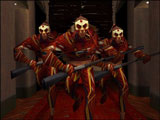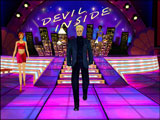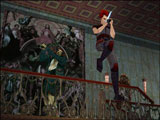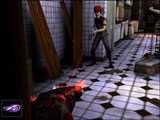| “Devil
inside, devil inside…” over and over again. Delivered in this hyper-raspy
Michael Hutchence wannabe timbre. That’s how it’s been ever since the editors
passed me TalonSoft’s “The Devil Inside” pc game. “What’re you
working on? Oh, yeah. ‘Devil inside, devil inside…’”. The joke’s
okay until Rick starts doing the batdance and Al ties his front shirttails into a knot
over his bellybutton and starts voguing. Actually, Al and Rick’s shenanigans are in
keeping with the campy atmosphere and goofy story of “The Devil Inside” and
suggest the preferred sensibility players might adopt while they play this game.  Other reviews
of “The Devil Inside” (“DI”) have been spotty. Some critics assert
that “DI” is the worst game ever released, or at least the worst game they’ve
played in a while. Others claim it is a worthy successor of (or at least a step-cousin to)
the “Resident Evil” franchise. Not content to rest in either camp, I’ll
stick to the road and say that “DI” is a pretty good game with some commonplace
glitches. Other reviews
of “The Devil Inside” (“DI”) have been spotty. Some critics assert
that “DI” is the worst game ever released, or at least the worst game they’ve
played in a while. Others claim it is a worthy successor of (or at least a step-cousin to)
the “Resident Evil” franchise. Not content to rest in either camp, I’ll
stick to the road and say that “DI” is a pretty good game with some commonplace
glitches.
 Before
addressing the good and bad points, here’s a few words on the story: In “DI,”
players assume the role of Dave Cooper, a pretty-boy tough-guy who used to fight crime for
the LAPD before his scorching good looks and blistering wisecracking landed him a gig as a
gumshoe-gunslinger for the controversial WWWL@ television network. What makes WWWL@
controversial? Namely, its shady emcee, Jack T. Ripper, and its paranormal content, both
of which rival SSSW network contends are sensationalistic pabulum manufactured to exploit
a stultified and superstitious viewing public. DI actually occurs as an episode of a
popular television series of the same name, which is sort of like a bastardized “COPS”
cum “X Files” show replete with in-your-face camera work and freakish
pandemonium. Before
addressing the good and bad points, here’s a few words on the story: In “DI,”
players assume the role of Dave Cooper, a pretty-boy tough-guy who used to fight crime for
the LAPD before his scorching good looks and blistering wisecracking landed him a gig as a
gumshoe-gunslinger for the controversial WWWL@ television network. What makes WWWL@
controversial? Namely, its shady emcee, Jack T. Ripper, and its paranormal content, both
of which rival SSSW network contends are sensationalistic pabulum manufactured to exploit
a stultified and superstitious viewing public. DI actually occurs as an episode of a
popular television series of the same name, which is sort of like a bastardized “COPS”
cum “X Files” show replete with in-your-face camera work and freakish
pandemonium.
In an attempt
to rend the shroud of sham that cloaks WWWL@ programming (and in a bid for broadcasting
supremacy), SSSW sends their own version of broadcasting badass to the DI “set”:
Ms. Angelina Axelrod. Angelina is supposed to provide an antithesis to the dark and
sarcastic Dave Cooper; he is suspicious, she is curious; he seeks the sensational, she
goes after the facts; he believes what he sees, and she trusts only scientific method. Of
course, it all goes badly for Angelina and Dave has to play the hero. But this isn’t
the mission of the game. Rather, Dave’s assignment is ridding a haunted Hollywood
mansion, Shadow Gate, of the spiritual minions of the—get this—Night Howler, an
insane serial torturer and murderer who had been executed for his crimes and somehow got
sprung from his eternal damnation in Hell because of some afterlife technicality. I won’t
get into the theological subtleties of “DI” here, but rest assured that they are
as silly-assed as anything posited in “Dogma.” But the game wasn’t designed
to please the Thomists out there. It’s supposed to be fun, and that it is.
 One of the most
entertaining components of “DI” is this “live-action” television show
concept that frames the game. The game moves back and forth between Dave, who is
constantly trailed by a cameraman, and the DI set, which is glitzy, packed with a live
studio audience, lots of neon and scantily clad, uh, hostesses, and dominated by big
screens and Jack T. Ripper’s podium. Ripper’s job is to egg on the audience and
Dave, and to supplement our hero’s terse, witty comments—“You just lost
some weight, buddy” when he blows off a zombie’s head and “Do you need a
hand?” when he blasts away an arm—with zany commentary and advice. Ripper’s
remarks aren’t always reliable, however, and players always risk clobbering if they
take his advice. While some might assume that this banter could become annoying, “DI’s”
developers use it pretty tastefully, and it adds a lot of character to the game.
Admittedly, the shift between studio and live-action cameras is sometimes jarring and
disconcerting, but it fits the chaotic mood of the game. Also, when rapid shifts do occur,
players can expect to get locked into some hairy combat when the commercial’s over. One of the most
entertaining components of “DI” is this “live-action” television show
concept that frames the game. The game moves back and forth between Dave, who is
constantly trailed by a cameraman, and the DI set, which is glitzy, packed with a live
studio audience, lots of neon and scantily clad, uh, hostesses, and dominated by big
screens and Jack T. Ripper’s podium. Ripper’s job is to egg on the audience and
Dave, and to supplement our hero’s terse, witty comments—“You just lost
some weight, buddy” when he blows off a zombie’s head and “Do you need a
hand?” when he blasts away an arm—with zany commentary and advice. Ripper’s
remarks aren’t always reliable, however, and players always risk clobbering if they
take his advice. While some might assume that this banter could become annoying, “DI’s”
developers use it pretty tastefully, and it adds a lot of character to the game.
Admittedly, the shift between studio and live-action cameras is sometimes jarring and
disconcerting, but it fits the chaotic mood of the game. Also, when rapid shifts do occur,
players can expect to get locked into some hairy combat when the commercial’s over.
In order to
extend and enrich the notion that players are participating in a live action program, game
play is seamless, notwithstanding the commercial breaks and camera shifts mentioned above.
So there are no levels in “DI.” All action occurs around and in Shadow Gate. And
while players must backtrack at times, this repetition, too, adds more depth to the “live-action”
concept that unifies the game.
 In terms of
actual gaming controls, “DI” features a standard customizable keyboard/mouse
combo. Character and camera control are solid, although the camera options in “DI”—players
can choose an isometric, side scrolling, or first-person cameraman point of view—aren’t
very useful. It is kind of cool to pause during the game and try the different cameras,
but the options don’t really enhance game play or strategy in any significant way.
They DO, however, mess with game design and virtual reality possibilities—Who REALLY
designs the games? Programmers or players? Who’s watching who? Says who?—in
compelling ways. “Thief II” toyed with such questions in more complex ways, but
“DI” persists in exploring these ideas with absurdity and humor. Also, control
and animation slows and becomes woody when there is too much going on aurally and
visually; when open flames and reanimated corpses proliferate, the game play and sound
tend to get sticky. In terms of
actual gaming controls, “DI” features a standard customizable keyboard/mouse
combo. Character and camera control are solid, although the camera options in “DI”—players
can choose an isometric, side scrolling, or first-person cameraman point of view—aren’t
very useful. It is kind of cool to pause during the game and try the different cameras,
but the options don’t really enhance game play or strategy in any significant way.
They DO, however, mess with game design and virtual reality possibilities—Who REALLY
designs the games? Programmers or players? Who’s watching who? Says who?—in
compelling ways. “Thief II” toyed with such questions in more complex ways, but
“DI” persists in exploring these ideas with absurdity and humor. Also, control
and animation slows and becomes woody when there is too much going on aurally and
visually; when open flames and reanimated corpses proliferate, the game play and sound
tend to get sticky.
The graphics in
“DI” are decent. Particularly impressive are the architectural nuances of Shadow
Gate. In this decrepit hellhole, mirrors accurately reflect whatever’s in front of
them (there’s that “Who’s watching who” motif again, at least when
Dave’s looking in the mirror staring back at the player), toilets flush, and torn
paintings reveal brown paper backing. The characters aren’t as convincingly rendered,
but they look pretty good, especially when viewed isometrically. This visual disparity may
reflect—or add to—the idea that a jarring difference separates what falls into
our line of vision in the world and what the television deposits there for us. “DI”
also calls into question the nature of celebrity and what it demands of those who want it.
Dave, for example, has a televised antithesis in Angelina, but his alter-ego is Deva, a
fearsome and buxom demonette who dispatches stray souls to her master Lucifer after Dave
has dealt with their fleshly incarnations. As the game progresses, players wonder how Jack
T. Ripper’s celebrity depends on Dave’s peril, or whether Dave matters at all
without Ripper.
 So “The
Devil Inside” is pretty good entertainment. Challenging and compelling gameplay and
story more than make up for mediocre graphics and the occasional technical snafu. If asked
to issue a withering bitch about “DI,” I’d have to point to the game’s
documentation and say that it’s complete crap. The manual consists of eight graphics
heavy pages that give players some ironic fluff but say little or nothing about options,
game play, control or strategy. Still, even this minimalism says something substantive
about “The Devil Inside”: there’s nothing new here, but what more needs to
be said or done on the topic of PC gaming fun? Coulda, shoulda and woulda, maybe, but
“DI” still delivers enough familiar action/adventure shenanigans to make it an
adequate holiday diversion. So “The
Devil Inside” is pretty good entertainment. Challenging and compelling gameplay and
story more than make up for mediocre graphics and the occasional technical snafu. If asked
to issue a withering bitch about “DI,” I’d have to point to the game’s
documentation and say that it’s complete crap. The manual consists of eight graphics
heavy pages that give players some ironic fluff but say little or nothing about options,
game play, control or strategy. Still, even this minimalism says something substantive
about “The Devil Inside”: there’s nothing new here, but what more needs to
be said or done on the topic of PC gaming fun? Coulda, shoulda and woulda, maybe, but
“DI” still delivers enough familiar action/adventure shenanigans to make it an
adequate holiday diversion.
Greg
Matthews |
